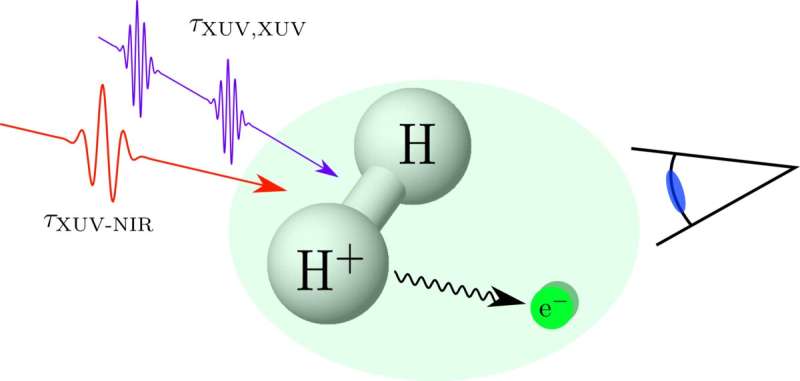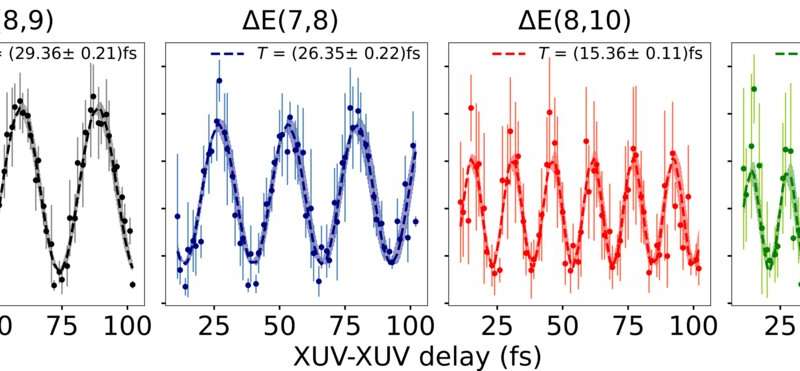Center stage for quantum mechanical entanglement in an attosecond laser laboratory

Quantum mechanical predictions challenge intuitive human thinking developed through the way that we experience the everyday world around us.
Among other things, quantum objects can display both particle- and wave-like character, can interfere and can occur in the form of quantum superpositions. Arguably the biggest challenge of all is brought about by the fact that quantum mechanics does not adhere to our intuitive notion of local realism, that is, the notion that the results of measurements on objects reflect properties that are inherent to these objects. Quantum-mechanical entanglement represents a breakdown of local realism, and introduces the existence of non-locality, implying that the outcomes of measurements on an object A (“Alice”) can be influenced by measurements on an object B (“Bob”), without there being any interaction between objects A and B.
Entanglement naturally arises when a quantum system is split into two sub-systems. Common situations are spontaneous parametric down-conversion, where an incoming pump photon is split into a pair of signal and idler photons, and photoionization, where light absorption splits a neutral atom or molecule into an ion and a photoelectron. Afterwards, the wave function of the total system can be written as a sum of one or more product wave functions describing the individual parts. If the wavefunction can be written as just a single product, then measurements that are performed on part A (“Alice”) do not affect measurements that are performed on part B (“Bob”). However, if the wavefunction of the composite system can only be written as a sum of such products, then the system is entangled and the remarkable result emerges that measurements on “Bob” (with different outcomes possible according to the quantum-mechanical probability of each of these outcomes) will determine the outcome of subsequent measurements on “Alice,” even if “Alice” and “Bob” do not interact.
-
![Center stage for quantum mechanical entanglement in an attosecond laser laboratory]()
Measured momenta of the H+ ions after ionization by a phase-locked XUV attosecond pulse pair as function of delay to the probing NIR laser pulse (a) for an XUV-XUV delay of 29 fs corresponding to coherent excitation of vibrational wavepackets. (b) for an XUV-XUV delay of 45 fs, where the system is entangled. Via a Fourier transform of the delay scan data individual vibrational quantum beats can be identified (c)+(d). Crucially, the intensity of the peaks corresponding to nearest neighbor coherences (∆E8,9 and ∆E(7,8)) are very pronounced in the measurement with an XUV-XUV delay of 29 fs, and very weak for an XUV-XUV delay of 45 fs. Credit: Fig. MBI
-

Strength of the quantum beats shown in Fig.2 (c) and (d) as function of XUV-XUV delay. Credit: Fig. MBI
Based on the above, we may expect quantum entanglement to be a common feature within attosecond science (1 as = 10-18 s), the new branch of laser physics that emerged in the early part of this century, where the time-dependent dynamics of electrons is studied on its natural, sub-femtosecond (1 fs = 10-15 s) timescale. The generation of attosecond laser pulses via high-harmonic generation necessarily produces laser pulses with photon energies that exceed the binding energy of every conceivable atom, molecule or material, and therefore, photoionization is a common aspect of attosecond experiments. Still, up to now the possible role of entanglement in attosecond experiments did not receive any significant attention.
Attosecond experiments are commonly performed in the form of a pump-probe experiment, where a first laser (the “pump”) initiates dynamics of interest in the system under investigation and, after a variable delay, a second laser (the “probe”) interrogates the evolving system, producing an observable that can be measured as a function of pump-probe delay. In this manner, pump-probe experiments provide a movie of the evolving dynamics, which can be viewed repeatedly and slowly (frame by frame, if necessary) until the underlying processes are understood. In quantum-mechanical terms, pump-probe experiments rely on coherence, i.e. the existence of well-defined phase relationships between different parts of the system that is formed after interaction with the pump laser pulse. As we have shown in recent theoretical and experimental work, the degree of coherence is significantly reduced in quantum systems that display entanglement.
In the experiments and in the calculations, neutral hydrogen molecules (H2) were ionized using an attosecond pulse, producing an H2+ ion in the lowest-available, bound electronic state. In this state, a vibrational wavepacket was formed, i.e. a coherent superposition of vibrational states, describing the vibration of the molecule between an inner and an outer turning point. The vibration was detected using a near-infrared probe laser, which dissociated the molecule, producing an easily detectable H+ ion and a neutral H-atom. Given that the probability of this dissociation process strongly depends on the internuclear distance between the two protons, the experiment could observe the vibration of the molecule by monitoring the fraction of molecules near the outer turning point of the vibration as function of pump-probe delay. In line with previous experimental results, the H2+ vibrations could readily be measured, demonstrating coherence between the different H2+ vibrational states.
This situation radically changed when the attosecond ionization pulse was replaced by a phaselocked pair of attosecond ionization pulses, with a controlled relative delay. For some values of the delay, the H2+ vibrations could be observed as before, whereas for other values the vibrations became all but unobservable. An analysis of the time-delays for which the vibrational coherence was (un)observable, revealed that the degree of vibrational coherence in the H2+ cation occurred in competition with the degree of entanglement between the H2+ ion and the photoelectron produced in the ionization process.
In other words, the experiment provided direct evidence that in attosecond pump-probe experiments involving ionization, entanglement between the ion and the photoelectron that are produced by ionization by the pump laser pulse, constrains the coherence that can be observed when the probe laser interacts with the ion or photoelectron. As such, the experiment provides an important warning to the attosecond community, demonstrating that the outcome of pump-probe experiments is governed by the properties of the wave function of the complete quantum system, even when the experiment may only target observation of the dynamics within one of the sub-systems. The experiment also points at an interesting opportunity in, for example, studies aiming at the observation of attosecond to few-femtosecond charge migration, where the specific electronic coherences underlying the charge migration process can be revealed. Finally, these experiments draw attention to the emerging link between ultrafast laser spectroscopy and the field of quantum information, where the application of attosecond science research tools may create hitherto unsuspected opportunities.
The research was published in Physical Review Letters.
Decoding electron dynamics
Lisa-Marie Koll et al, Experimental Control of Quantum-Mechanical Entanglement in an Attosecond Pump-Probe Experiment, Physical Review Letters (2022). DOI: 10.1103/PhysRevLett.128.043201
Citation:
Center stage for quantum mechanical entanglement in an attosecond laser laboratory (2022, January 28)
retrieved 28 January 2022
from https://phys.org/news/2022-01-center-stage-quantum-mechanical-entanglement.html
This document is subject to copyright. Apart from any fair dealing for the purpose of private study or research, no
part may be reproduced without the written permission. The content is provided for information purposes only.
For all the latest Science News Click Here
For the latest news and updates, follow us on Google News.


